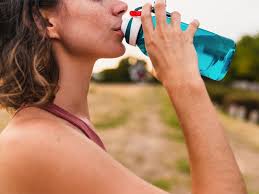A new hydration trend called “loaded water” is gaining popularity on social media platforms like TikTok. Advocates of this colorful and flavorful beverage claim it can increase energy, support electrolyte balance, and even reduce sugar cravings by providing a healthier alternative to sugary drinks. But does loaded water really deliver these benefits, or is it just another wellness fad?
Loaded water typically refers to water infused with ingredients such as fresh fruits, electrolytes, and prebiotics. These additions are intended to enhance the taste, add nutrients, and potentially improve overall health. With countless variations and creative recipes circulating online—from fruit-packed concoctions to fizzy prebiotic sodas—this trend has sparked curiosity. To better understand the potential advantages and drawbacks of loaded water, we consulted nutrition experts.
What Makes Loaded Water Appealing?
For many people, drinking enough plain water throughout the day is a challenge. The taste can feel dull, leading to insufficient hydration. Registered dietitian Kezia Joy, a medical advisor at Welzo, explains, “Plain water can be boring for a lot of people. Adding colorful ingredients is an effective way to make hydration more enjoyable.” From a behavioral standpoint, if infused water encourages more fluid intake, that alone is a positive outcome.
While plain water usually meets the hydration needs of most individuals, loaded water can offer more than just fluid replenishment. Joy notes that people may seek drinks that provide added benefits, such as increased energy, improved flavor, or support for gut health. The actual benefits depend heavily on the ingredients used.
Potential Benefits of Popular Loaded Water Ingredients
-
Coconut Water: Known for its natural sweetness and rich potassium content, coconut water is a common component of loaded water. According to Helen Tieu, a registered dietitian and founder of Diet Redefined, coconut water is particularly beneficial for people who engage in prolonged exercise or work in hot conditions. It helps replace potassium lost through sweat and contributes to maintaining energy and hydration.
-
Electrolyte Powders: These supplements often contain sodium, potassium, and magnesium—minerals vital for fluid balance, nerve function, and muscle performance. Tieu explains that replenishing electrolytes can stabilize blood sugar and energy levels, which in turn may help reduce sugar cravings often triggered by dips in energy or dehydration.
-
Fruits: Adding fresh fruit slices to water enhances flavor naturally while providing small amounts of micronutrients and antioxidants. This can make water more palatable and inviting, encouraging more frequent drinking.
-
Prebiotics: Ingredients such as inulin or chicory root fiber can support gut health by promoting a healthy digestive system. A well-functioning gut may improve nutrient absorption and sustain energy, contributing to overall wellness.
Are There Any Risks or Downsides?
Despite the appealing benefits, there are some potential drawbacks to loaded water:
-
Added Sugars and Calories: While a few slices of fresh fruit add minimal sugar, fruit juices, syrups, and commercial flavor powders can significantly increase sugar and calorie content. This could undermine the goal of cutting back on sugary drinks.
-
Excess Electrolytes: For some individuals, particularly those with high blood pressure or kidney disease, consuming too much sodium or potassium can be harmful. Electrolyte needs are typically met through a balanced diet, and supplementation should be approached cautiously.
-
Digestive Issues: Prebiotic fibers can cause bloating or gas in sensitive individuals. Kezia Joy points out that while prebiotic sodas and other trendy wellness drinks may benefit some, they don’t affect everyone the same way.
Loaded Water Versus Plain Water
Most people can meet their hydration requirements with plain water alone. However, loaded water can be especially helpful for those who dislike the taste of plain water or struggle to drink enough fluids.
Joy emphasizes, “Plain water works just fine. Trends like loaded water simply dress something simple up to make it more appealing. It’s not necessary but may be practical to encourage better hydration.”
Tieu agrees, adding that the main value of loaded water lies in helping people drink more fluids or replace less healthy sugary beverages.
How to Enjoy Loaded Water the Healthy Way
If you want to try loaded water, here are some expert tips to keep it healthy:
-
Use whole fruit slices instead of juices or syrups to minimize added sugars.
-
If using fruit juices or syrups, dilute them generously—aim for one part juice to five to ten parts water.
-
Start with small amounts of prebiotic ingredients to let your digestive system adjust.
-
People with health conditions like kidney or liver disease should consult a healthcare provider before adding electrolyte supplements.
-
For general hydration, aim to drink about 9 to 13 cups of water daily, depending on age, gender, and activity level.
Additionally, keeping a water bottle handy, setting reminders to drink regularly, and drinking water before and after meals can support good hydration habits. It’s also important not to overhydrate, as excessive water intake without balancing electrolytes can lead to imbalances.
Final Thoughts
While loaded water isn’t a magic solution, it can be a fun, flavorful, and customizable way to stay hydrated. The most important factor is simply consuming enough fluids throughout the day. Plain water remains an excellent choice for most people, but adding natural flavors and nutrients can encourage better drinking habits and provide some extra benefits, especially for active individuals.
Ultimately, whether you prefer plain water or a brightly infused glass of loaded water, the key is consistent hydration to support overall health and well-being.
